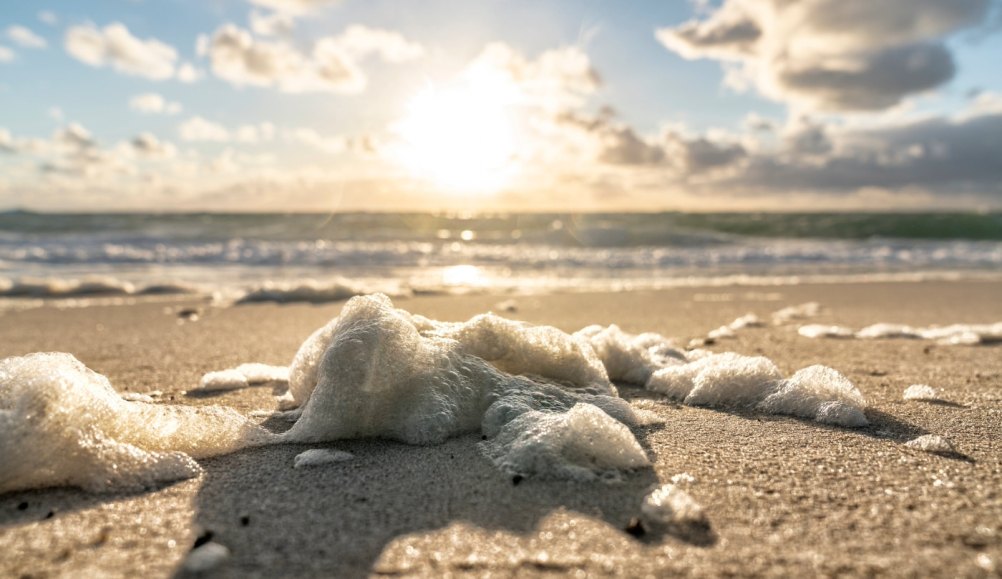Heat makes water evaporate. Now it appears light can, too
Green light had the strongest effect, though researchers don’t yet know why

Light could help water evaporate by breaking bonds between molecules, scientists propose. In nature, this process could occur where water contacts lots of air, such as in sea-foam or soils.
Tina Terras & Michael Walter/Moment/Getty Images
Share this:
- Share via email (Opens in new window) Email
- Click to share on Facebook (Opens in new window) Facebook
- Click to share on X (Opens in new window) X
- Click to share on Pinterest (Opens in new window) Pinterest
- Click to share on Reddit (Opens in new window) Reddit
- Share to Google Classroom (Opens in new window) Google Classroom
- Click to print (Opens in new window) Print
Green light means “go.” That might apply to evaporating water molecules, too.
On a warm sunny day, it’s no surprise to see a puddle dry up quickly. Heat causes the water molecules in the puddle to jiggle vigorously. That extra energy can break some of the bonds between molecules in the liquid. This allows some molecules to escape into the air as water vapor.
But some scientists now think there may be more to this evaporation story. The light itself — not just the warmth it brings — might spur water to evaporate. In experiments, green light, especially, seemed to make this happen.
Usually, scientists can figure out how much water will evaporate if they know how much heat is added. But in certain experiments, water under visible light evaporated faster than expected, based on heat alone — sometimes more than twice as fast.
Mechanical engineer Gang Chen and his team now think they know why. Single particles of light, or photons, can break the bonds between water molecules, their research suggests. This releases clusters of water molecules into the air.
The scientists work at the Massachusetts Institute of Technology in Cambridge. They shared their new findings in the Nov. 7 Proceedings of the National Academy of Sciences.
“This is super exciting stuff,” says chemist Yuki Nagata. He did not take part in the research. Nagata works at the Max Planck Institute for Polymer Research in Mainz, Germany. He notes that the proposed hypothesis needs additional checking. “We are not 100 percent sure this is really the mechanism,” he says. But if it is, it’s “totally new.”
Light, not just heat
Until now, visible light wasn’t thought to directly break the bonds between water molecules.
In their tests, the scientists shone different colors of light at water. The water was contained in a hydrogel. That’s a polymer that sops up lots of water. Different colors, or wavelengths, of light made the water evaporate from the hydrogel at different speeds. Green light was the fastest.
This difference between light colors supports the researchers’ hypothesis, says Janet A.W. Elliott. As a thermodynamicist, she studies the relationships between heat and other forms of energy. She works at the University of Alberta in Edmonton, Canada.
“If you just shine light on something, how do you know if it’s the light or the heat from the light that’s doing your job?” Elliott asks. If the color of the light makes a difference, “that’s evidence that the light part of it matters.” Another supporting piece of evidence? The phenomenon didn’t occur when a heater was used instead of light. So the extra evaporation couldn’t just come down to heat.
The speed of evaporation wasn’t the only surprise for the scientists. Their results also hinted at something special about how water molecules broke free. When heat drives evaporation, molecules typically escape one at a time. But when light is driving the evaporation, water molecules appear to escape in clusters. Then the clusters themselves evaporate. They break into individual water molecules and cool the vapor in the process.
But, Elliott adds, “there’s still lots of questions to be answered.” For example, the researchers don’t explain in detail how the photons could break the bonds. Another big question is why it works best with green light.
Chen agrees that there are still some unknowns in their explanation. Still, he hopes that this effect could be put to use for practical purposes. For example, it might lead to more efficient ways of making freshwater from saltwater.
The effect might be widespread in nature, Chen adds. It won’t happen in everyday puddles though. The effect can occur only where water is in contact with a lot of air, as in a hydrogel. So it might happen in water contained in crannies within soil or plants, or in sea-foam. “We have a feeling this is really happening daily, widely,” he says. “That’s why we’re very excited about this.”







